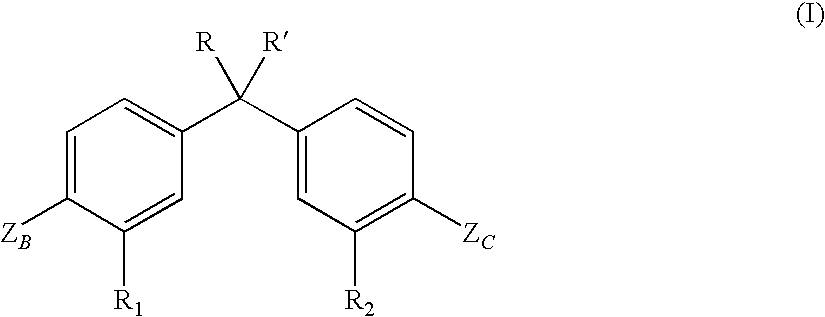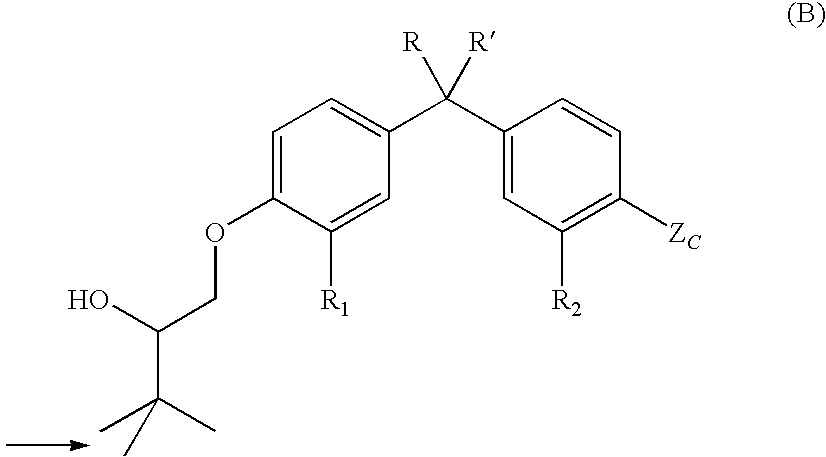Vitamin D receptor modulators
a technology of vitamin d receptor and modulator, which is applied in the field of ligand-dependent transcription factors, can solve the problems of insufficient separation to allow oral administration, hampered use of conventional vdr ligands, and inability to restore lost bone structure,
- Summary
- Abstract
- Description
- Claims
- Application Information
AI Technical Summary
Benefits of technology
Problems solved by technology
Method used
Image
Examples
example 1
Preparation of racemic 3′-[4-(2-hydroxy-3,3-dimethylbutoxy)-3-methylphenyl]-3′-[4-methoxycarbonyl-3-methylphenyl]pentane
[0305]
A. 3′,3′-Bis[4-hydroxy-3-methylphenyl]pentane
[0306]
[0307]To a mixture of o-cresol (196 g, 1.81 mol) and 3-pentanone (60 ml, 0.57 mol) is added methanesulfonic acid (45 ml, 0.69 mol) and stirred for 3 days. The reaction is basified to pH 8 with satd Na2CO3 and extracted with EtOAc. The organic layer is washed with water (6×500 ml), Na2SO4 dried, concentrated, chromatographed (2 kg SiO2, Hex to 80% EtOAc / Hex), and triturated with Hex to give the title compound as a white solid (100 g, 61%).
[0308]NMR 400 mHz (DMSO): δ 0.49 (t, J=7.3 Hz, 6H), 1.91 (q, J=7.3 Hz, 4H), 2.02 (s, 6H), 6.61 (d, J=8.3 Hz, 2H), 6.73 (d, J=8.3 Hz, 2H), 6.76 (s, 2H), 8.94 (s, 2H).
[0309]High Res. EI-MS: 284.1794; calc. for C19H24O2: 284.1776
B. 3′-[4-(2-Oxo-3,3-dimethylbutoxy)-3-methylphenyl)]-3′-[4-hydroxy-3-methylphenyl]pentane
[0310]
[0311]To a mixture of 60% NaH disp (8.0 g, 200 mmol) and ...
example 2
Preparation of racemic 3′-[4-(2-hydroxy-3,3-dimethylbutoxy)-3-methylphenyl]-3′-[4-carboxyl-3-methylphenyl]pentane
[0325]
[0326]A mixture of 3′-[4-(2-hydroxy-3,3-dimethylbutoxy)-3-methylphenyl]-3′-[4-methoxycarbonyl-3-methylphenyl]pentane (8.3 g, 19.4 mmol), EtOH (100 ml), water (100 ml) is added KOH (10.8 g, 97 mmol) and heated to 75° C. for 8 h. The reaction is concentrated with a stream of nitrogen and the residue is partitioned between 1:1 Et2O:EtOAc and 1N HCl. The organic layer is washed with water, Na2SO4 dried, concentrated, and chromatographed (gradient 20% EtOAc / MeCl2 to 30% EtOAc / CHCl3) to give the title compound as a white foam (7.85 g, 95%).
[0327]NMR mHz(DMSO): δ 0.54 (t, J=7.3 Hz, 6H), 0.92 (s, 9H), 2.05 (q, J=7.3 Hz, 4H), 2.10 (s, 3H), 2.47 (s, 3H), 3.45 (m, 1H), 3.76 (m, 1H), 4.02 (dd, J=3.3, 9.9 Hz, 1H), 4.78 (d, J=5.1 Hz, 1H), 6.83 (m, 2H), 6.92 (dd, J=1.8, 8.4 Hz, 1H), 7.05 (m, 2H), 7.72 (d, J=8.1 Hz, 1H), 12.60 (br s, 1H).
[0328]High Res. ES-MS: 435.2498; calc. for C...
example 3a and example 3b
Preparation of enantiomers of 3′-[4-(2-hydroxy-3,3-dimethylbutoxy)-3-methylphenyl]-3′-[4-carboxyl-3-methylphenyl)]pentane
[0329]
[0330]A mixture of racemic 3′-[4-(2-hydroxy-3,3-dimethylbutoxy)-3-methylphenyl]-3′-[4-carboxyl-3-methylphenyl)]pentane, Example 3, is chromatographed with a ChiralPak AD column to give enantiomer 1, Example 3A (110 mg, 37%) and enantiomer 2, Example 3B (110 mg, 37%).
Enantiomer 1, Example 3A
[0331]HPLC: ChiralPak AD (4.6×250 mm); 0.1% TFA / 20% IPA / 80% heptane; 1 ml / m (flow rate); Rt=6.2 m
[0332]NMR eq. To Example 2.
[0333]High Res. ES-MS: 411.2521; calc. for C26H36O4—H: 411.2535
Enantiomer 2, Example 3B
[0334]HPLC: ChiralPak AD (4.6×250 mm); 0.1% TFA / 20% IPA / 80% heptane; 1 ml / m (flow rate); Rt=7.3 m
[0335]NMR eq. To Example 2.
[0336]High Res. ES-MS: 413.2728; calc. for C26H36O4+H, 413.2692
PUM
| Property | Measurement | Unit |
|---|---|---|
| Frequency | aaaaa | aaaaa |
| Frequency | aaaaa | aaaaa |
| Molar density | aaaaa | aaaaa |
Abstract
Description
Claims
Application Information
 Login to View More
Login to View More - R&D
- Intellectual Property
- Life Sciences
- Materials
- Tech Scout
- Unparalleled Data Quality
- Higher Quality Content
- 60% Fewer Hallucinations
Browse by: Latest US Patents, China's latest patents, Technical Efficacy Thesaurus, Application Domain, Technology Topic, Popular Technical Reports.
© 2025 PatSnap. All rights reserved.Legal|Privacy policy|Modern Slavery Act Transparency Statement|Sitemap|About US| Contact US: help@patsnap.com



